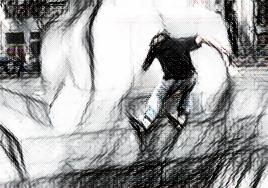Aggressive inline skating, a dynamic and thrilling action sport, originated in the early 1990s as a creative outlet for passionate rollerbladers.
The sport evolved from traditional rollerblading, incorporating elements of skateboarding, BMX, and freestyle scootering to create an entirely new and exciting discipline.
Early pioneers of aggressive inline skating paved the way for future generations of skaters by pushing the boundaries of what was possible on inline skates.
In the beginning, aggressive skaters adapted their rollerblades by modifying the frames, wheels, and boots to better suit their needs for grinding on rails, ledges, and ramps.
As the sport evolved, specialized aggressive inline skates were developed with unique features such as grind plates, soul plates, and UFS (Universal Frame System) frames to enhance performance and durability.
The rise in popularity of aggressive inline skating can be attributed to several factors, including media exposure, technological advancements, and the growth of the skate park infrastructure.
In the late 1990s and early 2000s, aggressive inline skating gained significant attention through events like the X Games and Gravity Games which showcased the sport's exhilarating nature.
The development of better equipment and the establishment of dedicated skate parks provided skaters with the tools and spaces they needed to practice and refine their skills.
As more people got involved in the sport, the global aggressive inline skating community grew, fostering a sense of camaraderie and friendly competition among skaters.
The rise of social media platforms and online video sharing sites like YouTube has also played a significant role in the sport's growth.
Skaters from around the world can now share their tricks, tutorials, and experiences, inspiring a new generation of aggressive inline skaters to take up the sport.
In recent years, aggressive inline skating has enjoyed a resurgence in popularity, with many former and new skaters rediscovering the joys of the sport.
Today, aggressive inline skating continues to thrive as a unique and captivating form of self-expression and athleticism.








